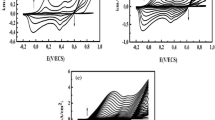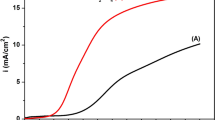Abstract
Polyaniline (PANI) films were deposited by electrochemical polymerization of aniline monomer on a fluorine-doped glass substrate at room temperature under different electric field directions. The as-synthesized PANI films obtained at different growth cycles were characterized by AC impedance spectroscopy and scanning electron microscopy (SEM). The results revealed that the film morphology, transport kinetics, and electrical properties are strongly dependent on the electric field direction and magnitude of the applied field during electropolymerization. The SEM morphology and AC impedance (modulus spectroscopy) indicate that a more homogeneous, high-porous, and conducting PANI film is induced by horizontal electric field direction (HEFD) electrodeposition, whereas the modulus spectroscopy of the PANI film deposited by vertical electric field direction (VEFD) reveals that VEFD deposition favours two-dimensional growth of PANI. The obtained polymer is more of dielectric in nature due to preferable dendritic growth which is supported by SEM analysis.











Similar content being viewed by others
References
Bhattacharjya D, Mukhopadhyay I (2012) Controlled growth of polyaniline fractals on HOPG through potentiodynamic electropolymerization. Langmuir 28:5893–5899
Wessling B (1998) Dispersion as the link between basic research and commercial applications of conductive polymers (polyaniline). Synth Met 93:143–154
Wang Y, Jing X (2004) Preparation of an epoxy/polyaniline composite coating and its passivation effect on cold rolled steel. Polym J 36:374–379
Wang Y, Jing X (2005) Intrinsically conducting polymers for electromagnetic interference shielding. Polym Adv Technol 16:344–351
Chandrakanthi N, Careem MA (2000) Thermal stability of polyaniline. Polym Bull 44:101–108
Persaud K (2005) Polymers for chemical sensing. Mater Today 8:38–44
Tang Z, Liu S, Wang Z, Dong S, Wang E (2000) Electrochemical synthesis of polyaniline nanoparticles. Electrochem Commun 2:32–35
Chen WC, Wen TC, Gopalan A (2002) Negative capacitance for polyaniline: an analysis via electrochemical impedance spectroscopy. Synth Met 128:179–189
Chen WC, Wen TC, Hu CC, Gopalan A (2002) Identification of inductive behavior for polyaniline via electrochemical impedance spectroscopy. Electrochim Acta 47:1305–1315
Kim YT, Yang H, Bard AJ (1991) Electrochemical control of polyaniline morphology as studied by scanning tunneling microscopy. J Electrochem Soc 138:L71–L74
Stilwell DE, Park SM (1988) Electrochemical studies on growth properties of polyaniline. J Electrochem Soc 135:2254–2262
Gholamian M, Contractor AQ (1990) Oxidation of formic acid at platinum microparticles dispersed in a polyaniline matrix: influence of long-range order and metal-polymer interaction. J Electroanal Chem 289:69–83
Ohsaka T, Ohnuki Y, Oyama N, Katagiri G, Kamisako K (1984) IR absorption spectroscopic identification of electroactive and electroinactive polyaniline films prepared by the electrochemical polymerization of aniline. J Electroanal Chem 161:399–405
Kobayashi T, Yoneyama H, Tamura H (1984) Electrochemical reactions concerned with electrochromism of polyaniline film-coated electrodes. J Electroanal Chem 177:281–291
Genies EM, Tsintavis C (1985) Redox mechanism and electrochemical behaviour or polyaniline deposits. J Electroanal Chem 195:109–128
Kitani A, Yano J, Sasaki K (1986) ECD materials for the three primary colors developed by polyanilines. J Electroanal Chem 209:227–232
Genies EM, Lapkowski M (1987) Spectroelectrochemical study of polyaniline versus potential in the equilibrium state. J Electroanal Chem 220:67–82
Gabrielli C, Keddam M, Nadi N, Perrot H (2000) Ions and solvent transport across conducting polymers investigated by ac electrogravimetry. Application to polyaniline. J Electroanal Chem 485:101–113
Bobacka J, Lewenstam A, Ivaska A (2000) Electrochemical impedance spectroscopy of oxidized poly (3,4-ethylenedioxythiophene) film electrodes in aqueous solutions. J Electroanal Chem 489:17–27
Hu CC, Chu CH (2001) Electrochemical impedance characterization of polyaniline-coated graphite electrodes for electrochemical capacitors—effects of film coverage/thickness and anions. J Electroanal Chem 503:105–116
Yang HJ, Bard AJ (1992) The application of fast scan cyclic voltammetry. Mechanistic study of the initial stage of electropolymerization of aniline in aqueous solutions. J Electroanal Chem 339:423–449
Deslouis C, Musiani MM, Tribollet B (1994) AC impedance study of transport processes in polyaniline membranes. J Phys Chem 98:2936–2940
Popkirov GS, Barsoukov E, Schindler RN (1997) Investigation of conducting polymer electrodes by impedance spectroscopy during electropolymerization under galvanostatic conditions. J Electroanal Chem 425:209–216
Vorotyntsev MA, Badiali JP, Inzelt G (1999) Electrochemical impedance spectroscopy of thin films with two mobile charge carriers: effects of the interfacial charging. J Electroanal Chem 472:7–19
Gazotti WA, Matencio T, Depaoli MA (1997) Electrochemical impedance spectroscopy studies for chemically prepared poly (O-methoxyaniline) doped with functionalized acids. Electrochim Acta 43:457–464
Lang G, Inzelt G (1999) An advanced model of the impedance of polymer film electrodes. Electrochim Acta 44:2037–2051
Mansfeld F, Lin S, Chen YC, Shih H (1988) Minimization of high–frequency phase shifts in impedance measurements. J Electrochem Soc 135:906–907
Venkataraman BH, Varma KBR (2005) Microstructural, dielectric, impedance and electric modulus studies on vanadium-doped and pure strontium bismuth niobate (SrBi2Nb2O9) ceramics. J Mater Sci Mater Electron 16:335–344
Lang G, Inzelt G (1991) Some problems connected with impedance analysis of polymer film electrodes: effect of the film thickness and the thickness distribution. Electrochim Acta 36:847–854
Lang G, Bacskai J, Inzelt G (1993) Impedance analysis of polymer film electrodes. Electrochim Acta 38:773–780
Tanguy J, Mermilliod N, Hoclet M (1987) Capacitive charge and noncapacitive charge in conducting polymer electrodes. J Electrochem Soc 134:795–802
Komura T, Yamaguti T, Takahasi K (1996) Impedance study of the charge transport at poly-O-phenylenediamine film electrodes. J Electrochim Acta 41:2865–2870
Rubinstein I, Sabatani E, Rishpon J (1987) Electrochemical impedance analysis of polyaniline films on electrodes. J Electrochem Soc 134:3078–3083
Pruneanu S, Veress E, Marian I, Oniciu L (1999) Characterization of polyaniline by cyclic voltammetry and UV-Vis absorption spectroscopy. J Mater Sci 34:2733–2739
Nunziante P, Pistoia G (1989) Factors affecting the growth of thick polyaniline films by the cyclic voltammetry technique. Electrochim Acta 34:223–228
Matsushita M, Kuramitz H, Tanaka S (2005) Electrochemical oxidation for low concentration of aniline in neutral pH medium: application to the removal of aniline based on the electrochemical polymerization on a carbon fiber. Environ Sci Technol 39:3805–3810
Kobayashi T, Yoneyama H, Tamura H (1984) Polyaniline film-coated electrodes as electrochromic display devices. J Electroanal Chem 161:419–423
Radosevic VH, Kvastek K (2007) Analysis of high-frequency distortions in impedance spectra of conducting polyaniline film modified Pt-electrode measured with different cell configurations. Electrochim Acta 52:5377–5391
Ravikiran YT, Lagare MT, Sairam M, Mallikarjuna NN, Sreedhar B, Manohar S, MacDiarmid AG, Aminabhavi TM (2006) Synthesis, characterization and low frequency AC conduction of polyaniline/niobium pentoxide composites. Synth Met 156:1139–1147
Grzeszczuk M, Olszak GZ (1993) Ionic transport in polyaniline film electrodes: an impedance study. J Eelctroanal Chem 359:161–174
Zhu D, Zhang J, Xu C, Matsuo M (2011) The frequency-dependence conduction of polyaniline based on their para-crystalline structures. Synth Met 161:1820–1827
Lee HT, Chuang KR, Chen SA, Wei PK, Hsu JH, Fann W (1995) Conductivity relaxation of 1-methyl-2-pyrrolidone-plasticized polyaniline film. Macromolecules 28:7645–7652
Ray DK, Himanshu AK, Sinha TP (2007) Structural and low frequency dielectric studies of conducting polymer nanocomposites. Indian J Pur Appl Phys 45:692–699
Han MG, IM S (2001) Dielectric spectroscopy of conductive polyaniline salt films. J Appl Polym Sci 82:2760–2769
Acknowledgments
The authors acknowledge Dr. Puyam Singh, Central Salt and Marine Chemical Institute (CSMCSIR), Bhavnagar for carrying out the scanning electron microscopy of our samples. We are thankful to the Department of Science and Technology (DST), Government of India for the financial support under the INSPIRE fellowship scheme for PhD studies of Kavita Pandey.
Author information
Authors and Affiliations
Corresponding author
Rights and permissions
About this article
Cite this article
Pandey, K., Yadav, P. & Mukhopadhyay, I. Influence of the magnitude and direction of electric field on the transport and growth property of deposited polyaniline films. J Solid State Electrochem 18, 453–463 (2014). https://doi.org/10.1007/s10008-013-2270-5
Received:
Revised:
Accepted:
Published:
Issue Date:
DOI: https://doi.org/10.1007/s10008-013-2270-5




